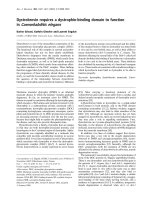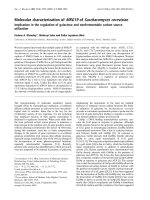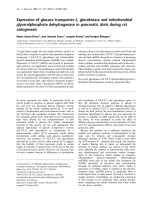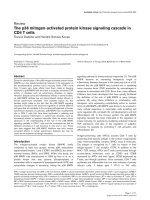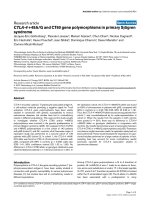Báo cáo y học: "Continuous subcutaneous glucose monitoring: good enough to use in glucose regulation protocols" doc
Bạn đang xem bản rút gọn của tài liệu. Xem và tải ngay bản đầy đủ của tài liệu tại đây (110.63 KB, 2 trang )
Tight glucose regulation is benefi cial in subgroups of
inten sive care unit (ICU) patients, but may harm other
sub groups. is harm may be due to hypoglycemic
events. In avoiding hypoglycemia, an accurate bedside
glucometry method is essential [1].
Bridges and colleagues therefore evaluated the accuracy
of a continuous subcutaneous glucose monitoring system
(CGMS) in critically ill children, and concluded that the
system proves highly accurate [2]. We have a problem
with this resolute conclusion. ey report a Pearson’s
correlation coeffi cient of 0.68, which is quite low. Vlkova
and colleagues even conclude that, based on a correlation
coeffi cient of 0.69 comparing subcutaneous glucose
values and laboratory blood glucose values in 15 patients,
subcutaneous devices should not be used in critically ill
patients [3]. We found a correlation coeffi cient of 0.87 in
evaluating the same CGMS in 60 critically ill patients,
but were concerned with the inaccuracy in the low
glucose zone: we found a diff erence of nearly 4 mmol/l
(reference blood glucose 2.8 mmol/l versus subcutaneous
sensor 6.5 mmol/l) in one patient [4]. Bridges and
colleagues report 142 subcutaneous glucose readings
<2.2 mmol/l that were falsely low, checked against blood
glucose values.
e Clarke error grid is a better way to evaluate the
accuracy of a CGMS than Pearson’s correlation coeffi -
cient. In most published studies, the deviation of subcu-
ta neous measurements stays in the (wide) clinically
accep table zones of the Clarke error grid. ese
deviations of the CGMS system, however, when used in a
tight glucose regulation protocol – and adjusting the
insulin dose based on the subcutaneous readings – could
have severe consequences in the individual patient, if the
deviations result in an unjust rise in insulin dose. Since
computerized protocols based on arterial blood samples
give excellent glucose regulation with a negligible chance
of hypoglycemic events [5], we decided to continue using
this computerized protocol to avoid treatment-related
morbidity. Subcutaneous CGMS seems not good enough
in aiming for tight glucose regulation in the ICU.
Intravascular CGMS, used in a closed feedback loop with
insulin infusion, is promising, but has not yet been
evaluated in clinical studies in critically ill patients.
© 2010 BioMed Central Ltd
Continuous subcutaneous glucose monitoring:
good enough to use in glucose regulation
protocols?
Jack JM Ligtenberg*, Margo E de Plaa and Jan G Zijlstra
See related research by Bridges et al., />LETTER
Authors response: Before dismissing continuous glucose monitors in ICU care, let us consider a role
Mark R Rigby, Brian C Bridges, Kevin O Maher and Catherine M Preissig
We appreciate the points raised by Dr Ligtenberg and
colleagues. ey suggest that because continuous glucose
monitor (CGM) evaluations have not exceeded a specifi c
Pearson’s coeffi cient, intro ducing their use in ICUs is
imprudent [2-4]. We believe the Pearson coeffi cient for
our data is strong (that is, >0.6) and our Clarke error grid
analysis (that is, Zone A + B >95%) and mean absolute
relative diff erence (15.3%) are in line with regulatory
agency approval of such devices, albeit for outpatient use
[2].
Unfortunately this group does not recommend an
acceptable Pearson’s coeffi cient, how a Pearson’s coeffi -
cient should be integrated with other objective assess-
ments, or how these criteria should be modifi ed depend-
ing on the proposed role of CGMs in ICU care. Agreed, it
would be premature to use data solely from CGMs to
direct insulin titrations in ICUs. As one hour or more
may pass between glucose checks in many ICU glycemic
*Correspondence:
Dept. of Critical Care, University Medical Center Groningen, Groningen,
TheNetherlands
Ligtenberg et al. Critical Care 2011, 15:403
/>© 2011 BioMed Central Ltd
control protocols, there may be important benefi ts of a
technology with minute-to-minute readings that closely
correlates with blood glucose levels. Adjunctive devices
that continuously display surrogate, but closely corre-
lated, patient data are not uncommon in ICUs, for
example end-tidal carbon dioxide readings are often used
as a proxy for arterial carbon dioxide levels and can be a
vital asset in the management of mechanical ventilation.
CGMs that display up-to-the minute glucose trends with
alarms set at critical thresholds (incorporating leeway for
inaccu racy) could be used to trigger routine blood
glucose measures to guide clinical management [2].
True, we had few (0.2% of >64,000) CGM readings and
no blood glucose readings of <40 mg/dl (2.2 mmol), and
thus cannot remark on the accuracy of CGMs in the
severe hypoglycemic range. Yet we contend that if CGM
devices can help maintain blood glucose levels in normo-
glycemic ranges they may provide critical assistance in
avoiding hypoglycemia and thus their precision in low
blood glucose ranges may be of less importance.
Abbreviations
CGM, continuous glucose monitor; CGMS, continuous subcutaneous glucose
monitoring system; ICU, intensive care unit.
Competing interests
The authors declare that they have no competing interests.
Published: 28 January 2011
References
1. Vogelzang M, Ligtenberg JJ: Practical aspects of implementing tight
glucose control in the ICU. Curr Opin Clin Nutr Metab Care 2007, 10:178-180.
2. Bridges BC, Preissig CM, Maher KO, Rigby MR: Continuous glucose monitors
prove highly accurate in critically ill children. Crit Care 2010, 14:R176.
3. Vlkova A, Dostal P, Musil F, Smahelova A, Zadak Z, Cerny V: Blood and tissue
glucose level in critically ill patients: a comparison of di erent methods of
measuring interstitial glucose levels. Intensive Care Med 2009, 35:1318.
4. Corstjens AM, Ligtenberg JJ, Horst ICC, Spanjersberg R, Lind JSW, Tulleken J,
Meertens JH, Zijlstra JG: Accuracy and feasibility of point-of-care and
continuous blood glucose analyzing in critically ill ICU patients. Crit Care
2006, 10:R35.
5. Vogelzang M, Loef BG, Regtien JG, van der Horst IC, van Assen H, Zijlstra F,
Nijsten MW: Computer-assisted glucose control in critically ill patients.
Intensive Care Med 2008, 34:1421-1427.
doi:10.1186/cc9374
Cite this article as: Ligtenberg JJM, et al.: Continuous subcutaneous glucose
monitoring: good enough to use in glucose regulation protocols? Critical
Care 2011, 15:403.
Ligtenberg et al. Critical Care 2011, 15:403
/>Page 2 of 2



